Epidemiology Arising: A Pharm Exec Roundtable
Experts from industry and academia probe the changing role of the pharmacoepidemiology function as it grapples with the challenges of big data analytics, tightening drug safety requirements, growing post-approval study burdens, and payer expectations around the application of real-world evidence.
“Value” is the metric that counts in certifying new products for payer reimbursement. But defining that value is a complex, messy, multi-polar task-one that many observers of the process now say should not be left to

the cost fixations of academic economists. In this new world of evidence, beyond the narrow parameters of the randomized clinical trial, experience with the actual patterns of disease by flesh and blood patients has brought new attention to the contributions that epidemiology can make to population health, drug development, and market access. On June 4, Pharm Exec brought a group of pharmacoepidemiology experts to discuss how this below-the-radar function is adapting to a “show-me-the-outcome” system of healthcare.
William Looney, Pharm Exec: Product approval in biopharmaceuticals is moving from proof of safety and efficacy to establishing a strong benefit-risk and economic profile-one that appeals to payers and patients as well as regulators. This fundamental shift is transforming the role of the in-house pharmacoepidemiologist at every stage of the drug development and commercialization cycle. Can we identify the key forces driving the change as well as their impact in redefining the mandate of this mission-critical function?
John Doyle, Quintiles: We face a major transition in the way healthcare is financed and delivered. For the pharmacoepidemiology function (“epi,” for short), this requires a different approach to drug development. Beyond the basic parameters of safety and effectiveness, it is now necessary to demonstrate the value of a new medicine to a wider range of stakeholders, beyond the regulator. But exactly what is this concept of value we are aiming for? The answer requires that we begin with a clear perspective of what proof points stakeholders are seeking for the future state of healthcare. It’s all about the patient: the key players, from payers and insurers to drug manufacturers, physicians, retail pharmacists, and the integrated hospital networks, have endorsed patient centricity as the ultimate destination.
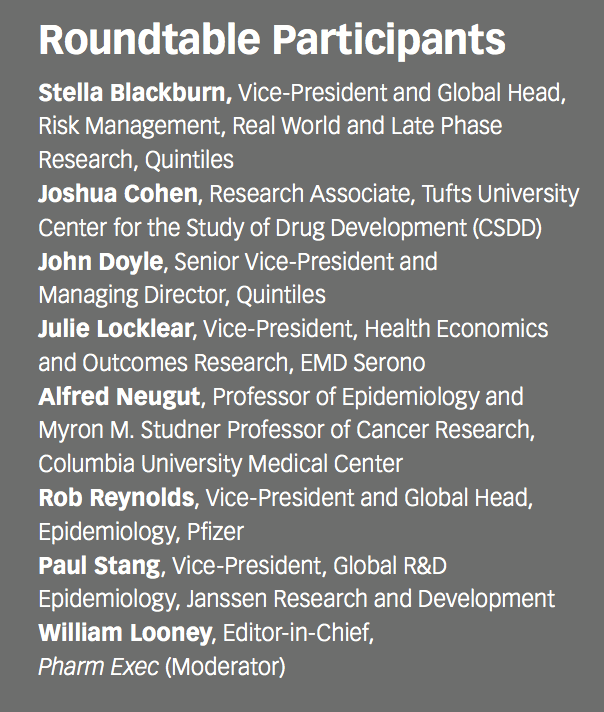
The challenge is that adoption of this new patient-driven value metric is not proceeding in a linear fashion-the stakeholders differ in the pace of progress. Not only do we see gaps in the adoption of patient centricity among individual segments of the healthcare business, there are variations in readiness at the geographic level. Overcoming the gaps requires a stronger commitment to service-and, more importantly, information-integration. We also need a common vision of population health linked to the achievement of better value and outcomes. With its capabilities to assess the risks and benefits of a health intervention across a broadly diverse study set, in actual clinical practice, the epi function is one of the key elements of a strategy to make that happen.
There is so much that needs to be investigated with observational research methods that extend further than the carefully prescribed parameters of a randomized clinical trial to the real world. Epi work allows us to see that patients will behave differently when they are asked to participate as active consumers of healthcare (i.e., the “Hawthorne Effect”). Payer reliance on utilization controls like tiered co-pays is becoming more prevalent and reliable observational data can take us much further in assessing the long-term impact of these tools on value and outcomes. Likewise, you have the giant retail pharmacy and drug distributors now leveraging claims data to understand better what motivates the patient-what are their health-seeking behaviors? Can we take information on consumer buying habits at the front of the store in retail pharmacy and apply it to shape actions when the patient has to fill a prescription and navigate through all those co-insurance and co-pay channels?
The conclusion I take from this is pharmaceutical companies must upgrade and accelerate the manner in which they collect, analyze, and apply “big data” to attain a premium position on that summit we call
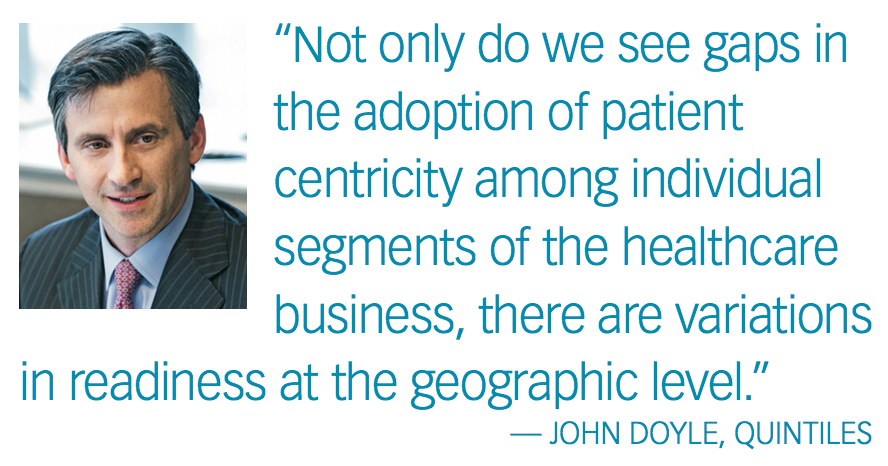
patient centricity. Some stakeholders are already well ahead in this race, including the integrated hospital systems like Kaiser and Geisinger, which are applying big data to develop their own clinical guidelines and formularies to evidence value from the pharmacy benefits they provide to covered populations. Drugmakers are already under scrutiny for the short-term costs of medicines on the health system. The industry has no choice but to step up and validate the benefits, risks, and outcomes from use of its products.
In a patient-centric model of care, the determinant of value is going to be what Harvard Professor Don Berwick codified as the “triple aim.” That is, are you (1) solving for population outcomes, (2) enhancing the patient experience on his/her care journey, and (3) doing both while saving money for the system overall? This is the real question that the pharmacoepidemiology function in your companies will have to answer to stay relevant. The future is not about a siloed dialogue around one drug, one physician, and one patient. It is a dialogue driven by clinically relevant information, with the objective to reconcile that individualized intervention with system-wide efficiency and cost savings goals. We are definitely entering a new era of healthcare catalyzed by real-world research.
Data don’t tell all
Paul Stang, Janssen: Further progress in health reform depends not just on amassing the data made available through technology advances. The reliability of these data as a basis for informed decision-making is even more important. The problem we see with big data is the benefits from a particular intervention are often not revealed in the clinical record. People don’t go to their physician just to say how good they are doing; there is no ICD-9 code for “feeling better.” Those who work in the epi field must avoid the tendency to analyze only what we can measure. There is a much bigger picture that is obscured because our current data methodologies don’t take account of it. Grasping and making sense of that bigger picture has to be part of the epi agenda.
Joshua Cohen, Tufts CSDD: There is not only an asymmetry in information, the systems that allocate prices and costs for medicines are, in my view, irrational. Consider the structure of patient cost-sharing for physician-administered drugs here in the US. Despite many differences in the clinical performance and, hence, the value of these drugs, we see co-insurance rates of 20% or more applied across the board. Also, in Europe, patient cost-sharing is usually calculated at a fixed amount for all drugs, which provides little incentive to utilize high-value products.
Stella Blackburn, Quintiles: In the UK, patients pay a fixed co-pay for a prescription, regardless of what the drug costs the National Health Service (NHS). Combined with the pressure on physicians to prescribe the cheapest drug available for a condition, and to use generics where possible, this means that, in some cases, the co-pay amount imposed on the patient may actually be higher than the cost of the drug itself. And that assumes the drug is offered through the NHS at all-not all authorized medicines are available in the UK. The National Institute for Health and Care Excellence (NICE) follows criteria for the cost-effective assessment of new medicines that reflects its own distinctive approach to value but may sometimes be at odds with the preferences of society at large. You have heard the stories. NICE approved access to Viagra but allegedly would not initially finance an important new drug for macular degeneration until the patient was blind in one eye. Also, in vitro fertilization can be provided by the NHS while some oncology drugs are not. It is hard to quantify the logic behind these disparate judgments. It would help if industry had better ways through data to document why this regulatory approach is sometimes too narrow and short-sighted.
Answers beyond cost
Looney: What are the implications for pharmacoepidemiology of including a drug’s cost in determining its value to payers, providers, and patients? How is the incorporation of this economic evidence in access and P&R decisions likely to shape priorities of the in-house epi team?
Doyle: It certainly ordains a larger, more visible role. Epi work has been concentrated on identifying populations targeted for disease indications as well as assessing risk vs. benefit on specific therapeutic interventions. If value becomes the focal point of a drug’s market potential, and efficacy gives way to the concept of effectiveness, in which cost is a major variable, then the consensus is that pharmacoepidemiology can best serve as an integrator of the various data-driven functions that ultimately drive market access-for example, HEOR, Medical Affairs, or Key Account Management. Development of patient registries and benefit/risk profiling are examples of specific tasks that can be addressed through epi. That is the more strategic role we see going forward.
Rob Reynolds, Pfizer: One activity for epi is identifying the right patient population for the drug, early in development. The goal is to optimize the benefit and minimize the risk in a targeted subset population, showing to regulators that the compound will work as intended and yield a positive health outcome. The ideal time to do the work is at the Phase IIB stage of a trial, or early in phase three, but not later. Such data can also be useful to the payer because it provides a strong indication that value will be optimized in the actual clinical setting.
Alfred Neugut, Columbia University Medical Center: We are in a grey area today. The familiar certainty of the randomized controlled trial (RCT), where one drug can be shown as statistically superior to another, is yielding to different measures that are harder to quantify. For example, in oncology trials, it is now common for quality of life and cost factors to be assessed in parallel with survival and other standard end points. If you look at where reimbursement is moving-toward bundled payments-then the template for this kind of research will always put the least costly drug at the top of the value chain. Why should anyone pay for the more expensive drug under such circumstances? This is a bit limiting.
Stang: The pharmacoepidemiologist might see things differently than the health economist. Each profession uses and interprets data differently. Epi has a more inclusive, complex view of data and this leads us to a less definitive conclusion than that of the health economist, who is inclined to say that the cheaper drug has greater value simply because it costs less; they have all the relevant cost/charge data available to them in the database. I wonder if payers have any incentive to see the distinction between the two approaches.
False pretenses?
Julie Locklear, EMD Serono: Payers are constantly looking for data to inform formulary decision-making. Comparative effectiveness data is routinely part of payer requests. As a manufacturer, we aim to conduct robust, reliable and relevant studies evaluating comparative effectiveness research (CER), real-world evidence [RWE], and RCTs to help payers in making formulary choices. There seem to be situations where products have demonstrated clear clinical superiority over the current standard of care, and are bolstered by a strong economic value argument, yet still don’t get a listing on the formulary. It leads one to conclude that the rationale for payer decisions is contradictory and does not always follow the evidence.
Stang: We haven’t mentioned the elephant in the room, which are attitudes toward the industry’s evidence and the extent to which it may/may not be biased. Industry does bring in independent third-party groups to help vet its study research and abides by peer-review publishing rules that stipulate disclosure of the sponsoring organization. I think it’s time we in the industry started pushing back. If the science is as good as we profess it to be, it ought to be able to stand on its own.
Blackburn: Value proposition research carries a tendency to reduce real people to data points-a homogenous blob. It’s an assumption industry must work to dispel. We don’t go far enough in trying to clarify the factors that will predict a benefit to the individual patient. Epi gives us potential tools to do that; with them, we can realize the promise of personalized medicine by identifying “benefit factors” and using these to predict individual response to a drug. I would add that industry devotes disproportionate attention to singling out risks compared to benefits, when most desperately ill patients are much more interested in the latter. The same holds true for side-effect profiling. One side-effect may not matter to one patient but may be hugely important to another.
Neugut: Personalization of drug therapy is the hottest area of epi right now. Optimism is widespread that personalized medicine will render moot some of the objections to the high cost of medicines. We can drill down and identify the best subset of patients who will truly benefit from access to an expensive drug, helping payer manage their cost exposure. At present, for every 100 patients, we treat all of them yet provide a benefit for only 20; all 100 also get the side-effects. Biomarkers and other tools mean we can provide that expensive drug to only those 20, while the funds once spent on the remaining 80 can be applied elsewhere. Pharmacoepidemiology research provides a very valuable service here.
A patient agenda for epi
Looney: As a group, can we conclude that being “patient centric” depends on three research commitments as the basis for accumulating evidence of value? These include: (1) focused attention to the benefits as well as the risks in granting patient populations access to a new drug; (2) assessing side-effects from the perspective that each patient will experience these differently; and (3) developing evidence that will allow clinicians to prescribe the right therapy for the right patient. Anything else?
Blackburn: I would add to this a commitment to treat the patient, not the disease.
Reynolds: Pfizer is doing more to explore directly with patients what their preferred trade-offs are between risk and benefit. We are proposing studies relatively early in development where we work with patients to better understand what they would value most in a particular medicine-how much risk in terms of side-effects they would tolerate in return for symptom relief or a higher quality of life. This also allows us to make the case to the approval authorities that certain risks are acceptable to the prospective patient population.
However, I’d emphasize that patient centricity, narrowly defined, is unlikely to make a huge difference in moving a drug candidate across the approval line. There are exceptions, of course. Lotronex and
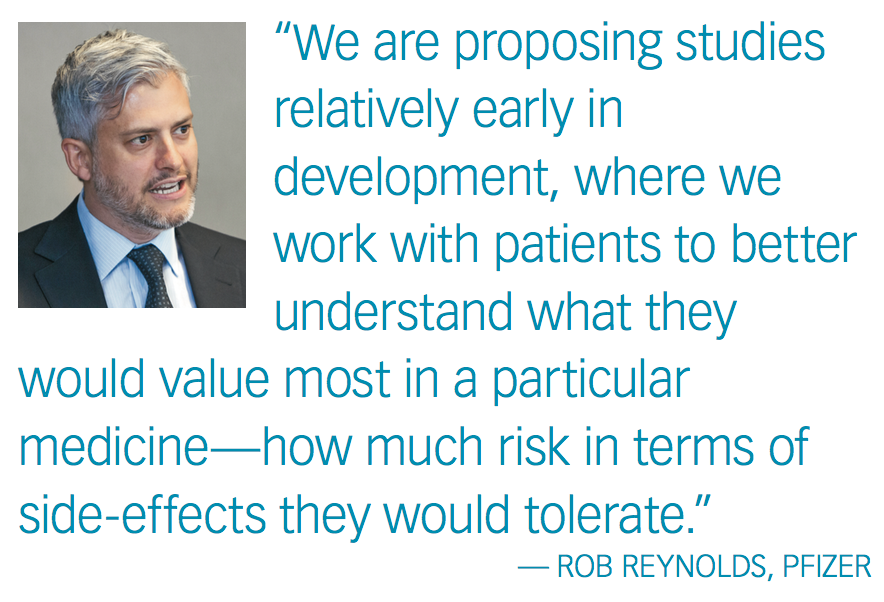
thalidomide for leprosy are examples where I think the patient view has been hugely important to regulatory approval. In my experience, arguments focused on patient convenience or accessibility that we uncover during development hold less sway with how the FDA and its panels decide. This is why we need to get beyond those so-called patient factors such as convenience or dosage regimens to improve adherence. Rather, we can define patient-centric drug development as bringing medicines to market that matter most to patients, such as those that significantly increase years of life or offer cures, and finding ways to understand patients’ tolerance to accept risks for certain types of benefits.
Stang: There is an evolving methodology in epi-which Janssen is now putting to use-that seeks to capture quantitatively how patients evaluate the potential for harm from a particular drug against its benefits. Simply put, it is a statistically weighted utility measure that provides very useful insights on how patients approach the tradeoffs in a decision.
In fact, this work has been instrumental in at least one decision to kill a compound at a much earlier stage of development, which is more efficient financially. We presented the methodology graphically in a recent presentation to an FDA advisory committee reviewing Janssen’s blood thinner drug Rivaroxaban. It was well-received.
Pfizer and Eli Lilly have been conducting study research along similar lines. I expect other pharmaceutical companies to follow suit in applying these methods to weed out non-viable products before they starting draining money and resources. R&D today is all about managing finite resources, and this work puts us on the right path to a cost-effective, clinically relevant product proposition we can make to all stakeholders.
Regulatory challenges
Looney: This leads to a larger issue. If we agree that a more robust evidence base concerning patient perspectives on risk vs. benefit can open up the approval process, does this mean it will be accepted uniformly by different regulatory authorities? For example, do the FDA and EMA apply the same measures to secure the same result for the same product?
Blackburn: The evidence suggests they don’t. There are numerous discrepancies, simply because the application and evidentiary processes have been devised separately. A drug approved for sale in both jurisdictions may carry a different indication; the definition of the disease itself can vary. That means the calculation of risk and benefit will go in a different direction as well. Rotavirus is not the health problem in Europe that it is in the US; therefore, there will be different assessments of the benefit and risk of vaccines to prevent disease. The notion that standard approaches are somehow more efficient for industry requires a bit of caution. It might be more helpful to conclude there is no single best way to measure benefit against risk.
Stang: The big issue is whether payers are going to see any of these improved methodologies as an aid to the decision-making process on access and reimbursement-one that they will actually use and apply transparently. Can we make that connection?
Doyle: There is a common interest among both regulators and payers to see more real-world data through observational studies. Those responsible for drug approval have an interest in how the patient response in a clinical setting tracks their own assessment, while payers certainly would like to apply data from a patient registry to help document a value-driven decision to list a product on formulary. You could say that real-world data is the common denominator between the licensor and the payer.
Cohen: I agree. The first thing a P&T committee does when considering a listing is review the authorization package, including a meta-analysis of the risk-benefit studies submitted to key approval agencies worldwide, as well as other relevant research. One specific thing they are looking for is ways to stratify the eligible treatment population. They want to be able to know, with some objective probability, which category of patient will benefit most from the drug, or which patient will be more likely to suffer an adverse event. This feeds into the process for evaluating cost.
Blackburn: The need is certainly there. At the authorization stage, there is strong evidence of a drug’s overall efficacy, but little knowledge of its safety profile. Pressure is only going to grow to redress the gap through systematic reliance on real-world studies that can reveal the true balance between risk and benefit.
Locklear: Safety and risk are particularly important as we know more about the biology that underlies key diseases like cancer. Breast cancer or small cell lung cancer express themselves differently in individual patients; these
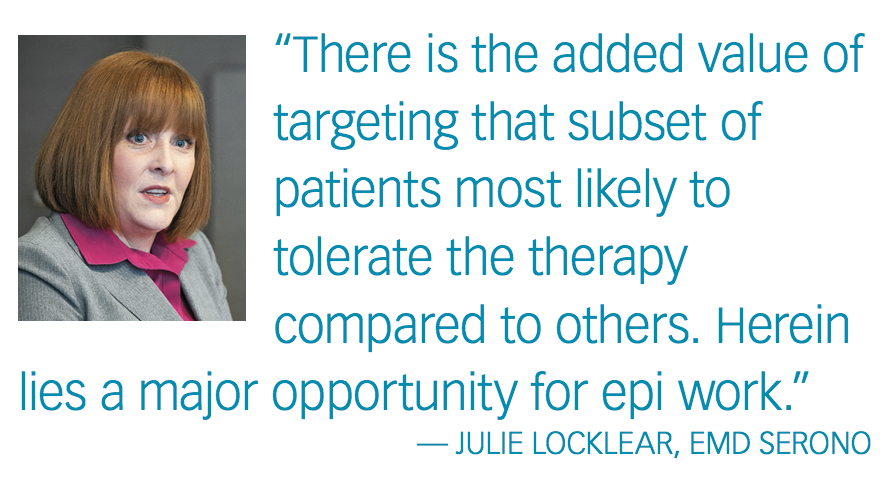
are not one disease, but many-and rare. This makes the identification of risk through real-world evidence a more daunting task, but the need to do so is equally evident. There is the added value of targeting that subset of patients most likely to tolerate the therapy compared to others. Herein lies a major opportunity for epi work.
Reynolds: In the past, pharmacoepidemiology was used infrequently in the oncology development and post-approval space. Epidemiology has always been important in oncology drug development-molecular epidemiology and natural history of disease studies have been key to identifying targets for many years. They will continue to be important as precision medicine approaches advance and genetic data are linked to electronic medical records (EMRs) and other data sources used by pharmacoepidemiologists. But until recently there were very few Phase IV observational study commitments on cancer drugs. Today, with the possibility of additional approvals for new indications, combined with the much larger data sets available, that scenario has changed. There are big opportunities for epi here, extending of course into other rare diseases.
Stang: Data and the methodologies to interpret it are developing in such a way as to allow for a better understanding of the way diseases actually affect patients. Providers and payers are focused on one disease at a time, when in fact the co-morbidity rate in most chronic diseases is high-60 to 70% of patients with a chronic disease have another. This raises many interesting areas for investigation, such as the impact of these co-morbidities on the effectiveness of the treatment being assessed-or could the treatment even be creating the co-morbidity itself? We are starting to see this with diabetes, depression, and other conditions that seem to have an inflammatory etiology.
Neugut: Another case for this kind of work is the litigation explosion. Adverse effects from drugs are almost always small and can be contained yet the “1-800-Lawyer” trend is well-established and in my view is out of hand, in proportion to the risk. Real-world evidence can help put the adverse events issue in its proper perspective.
Looney: There is an obvious lack of alignment on methodologies to develop real-world evidence, but, overall, do we see a genuine commitment from regulators to pursue a more patient-centered approach in their interactions with the industry?
Cohen: It is true we can see little harmonization among payers, particularly in Europe. A good example is the sharp variance between the evaluation methodologies employed by NICE in the UK and IQWiG in Germany. At the same time, there are signs of small incremental steps by numerous payer representatives toward risk-share contracting with individual companies. This does require acceptance of a clear methodology on benefit, how to allocate costs, and other elements of a pay for performance model: will the company rebate the payer if the drug doesn’t pass on performance or, alternatively, will the payer accept a higher price if the drug works? It’s a work in progress.
On patient centricity, we can see some effort to insert the patient perspective in outcomes measures, such as EuroQol in Europe and the Patient Centered Outcomes Research Institute (PCORI) here in the US. But the interesting question is how these new institutional structures feed in to actual decisions on access and reimbursement. It’s unclear. The big positive is the stakeholders are now listening to each other.
Epi research agenda-trending social?
Looney: Are there examples of large-scale long-term observation studies underway that in your view have the potential to advance the potential of epi and its new research tools?
Neugut: One big initiative is a multi-target study examining aspirin as a therapeutic agent for multiple cancers. There are several randomized trials in progress in such areas as aspirin, as a post-treatment and preventive for colon cancer. Another is with Celebrex. We should see all this work shaping the armamentarium on cancer in the next few years. One project we are completing at Columbia Medical Center is a randomized trial around use of text messaging to boost rates of adherence to medication.
Looney: How is social media shaping the environment for pharmacoepidemiology research?
Reynolds: The key players-Google, Facebook, Twitter, and IBM-are all seeking ways to harness their vast data streams for pattern recognition and other algorithms that yield insights on patient behavior. This approach has been effective in monitoring flu. Other infectious diseases are likely areas for investigation, particularly in tracing adverse events. I don’t believe social media is going to be productive in furnishing insights on individual cases; there is not enough detail, but it may be useful for detecting patterns for further evaluation that you are not picking up using conventional methods. One such example is in the post-launch cycle, when real-world data is still scant, you can tap patient commentary and physician-specific data streams that accumulate on social media.
Locklear: Another example is PatientsLikeMe, which is a rich source of real-time information for patients with rare diseases. Patients can come together and find that 100 other people have the same gene mutation and can, thus, expedite participation in a relevant clinical trial. This kind of community-building would be impossible without social media.
Stang: In our community health studies, we have been evaluating the work of social network scientists like Nicholas Christakis (an MD and PhD) to attempt to determine how an individual’s social network influences his or her health behaviors.
Doyle: New epi study designs are emerging to tap the opportunities unleashed by big data. One example is a hybrid design that links a retrospective evaluation using claims or EMR databases with information that is collected prospectively at the patient and population level. This as well as other opportunities can be leveraged to help epi build on the promise of big data and advanced analytics.
Stang: Janssen has adopted a similar model, which we call a readiness cohort. Data is compiled from following patients’ behavior, but we also test them as well to uncover data that cannot be captured by conventional means. When the patient crosses a certain threshold on these tests, he or she is invited to join a randomized pool. Now that technology gives us the opportunity to access truly large data sets, this is going to emerge as an important new area for pharmacoepidemiology research. Similarly, we are looking at opportunities to use “randomizing into the database” in the post-marketing phase, where in situations of clinical equipoise, a patient who consents is randomized to a choice which is then followed to track their health status over a period of time-but solely in their own EHR.
Leaning in to management
Looney: Is there a CEO perspective on this topic that bears mentioning?
Stang: The further up you go on the decision chain in a drug company, the more likely that the pharmacoepidemiology function gets placed in the bucket we call “real-world evidence.” I am not sure people in general management see any distinction between the two. It’s a perception we need to address, as our perspective in epi is necessarily broader.
Locklear: The best guarantee of our effectiveness internally is to display the skills and leadership traits that will attract the interest and commitment of senior management. Demonstrating timely value and relevant metrics to support these various epi initiatives will be critical to obtain leadership support.
Doyle: Every drug company CEO spends a good part of his or her day addressing external concerns on whether its medicines are adding value and generating beneficial health outcomes. There is ambiguity about what is meant by “value,” so anyone in the organization that can help the CEO grapple with it, particularly on the basis of sound methodological principles, will help make that job easier. The progression toward “value” came about when the discussion of risk expanded to place an equal priority on benefit. Balancing the two leads naturally to a focus on the patient-back again to the concept of patient centricity. This is an instinctive argument to make to the CEO. It’s a natural fit for epi.
What’s next
Looney: Looking ahead to the end of the decade, how will the big data revolution shape the way the epi profession conducts its work?
Neugut: Widespread adoption of the electronic health record (EHR) will provide new ways to drive patient care in a more clinically efficient and effective manner. If a health system wants to discourage use of procedures that evidence shows is marginally effective, the physician simply has to type in the proposed action and he or she will receive a “pop up” notice noting that “action is not recommended by guidelines, would you like to continue?” The physician can order the procedure anyway, but the action will be flagged for follow-up around the outcome: we can, thus, see if the pop up leads to a decline in utilization of that procedure and also how the decision shaped the outcome of the episode, and its cost. It’s a great tracking tool for the profession.
Reynolds: We will see the growth of additional new programs to capture big data for analytical insights. A strong precedent exists with the FDA Sentinel program, which coordinates safety and risk management activity using large integrated data sets built around a common automated model that can be applied to conduct individual studies. The effect of all this work will be to sharply reduce the time required to run such studies with such large populations; what once took several years can now be completed in as little as three months. As the time frame shortens, we can think about looking into events that may not be captured well in the data bases now in use, and bring in alternative sources of data like social media or clinical/patient registries on individual diseases.
Stang: Patient registries will become more prominent, but the jury is out on how efficient these will be in capturing data that is meaningful. Interest is strong from the medical device side, mainly because there are significant gaps in how the industry evaluates product quality and safety-there are still many unknowns. In pharma, the emphasis is on patient registries for orphan drugs or specialty products that carry very specific indications. They are usually established for a reason and, thus, I expect their use in the drug sector is going to grow. New methods related to this will emerge as well.
Blackburn: Patient registries serve an important function in pharmaceuticals. I would like to see a lot more registries set up to track the patient journey with a medicine. One problem we face in epi is that when patients switch drug therapy, as is often the case, their data goes into a different registry, if the registries are product-based. Sever the connection and the follow-up trail can go cold. That, in turn, makes it harder to render useful conclusions. We have to do better in utilizing disease registries to answer the key research question: Does giving drug A at a particular stage of disease progression lead to a health benefit? For how long? And does the sequence of treatment matter?
Another imperative is to get more creative about hybrid study design, such as introducing direct questioning of patients to obtain information not normally contained in a registry, then using one of the EHR databases to follow this group over time. Quintiles, as part of the PROTECT consortium, just conducted a study examining drug utilization during pregnancy. Patients told us a lot of things that could never be gleaned from the EHR; when we combined both streams and examined the results, we got insights that never would have been revealed by relying on one source alone. That’s the advantage of hybrid design.
Looney: Again, looking forward, how will the cost control and pricing environment shape priorities in pharmacoepidemiology?
Cohen: The evolution toward a “value-based” pricing system will continue in both the US and in Europe. I emphasize the word evolution, because neither market is really there yet. At its most basic, there is a lack of clarity on what “value” is supposed to represent. This makes it harder to build methodologies and metrics that have staying power and are applicable across different market segments and geographies. What will drive the agenda around value is the growing volume of data that exists to be tapped in pursuit of price regulation for biopharmaceuticals. The pressure to justify costs is going to intensify. And despite the sheer volume and accessibility of data, measures taken by payers will often seem arbitrary because of the underlying politics of budget austerity.
The biopharma industry and the payer must be realistic. Given the scale of the demographic transition over the next 20 years, the idea that healthcare costs overall are going to remain stable or shrink is a fantasy. We can bend the cost curve, but we cannot break it. The
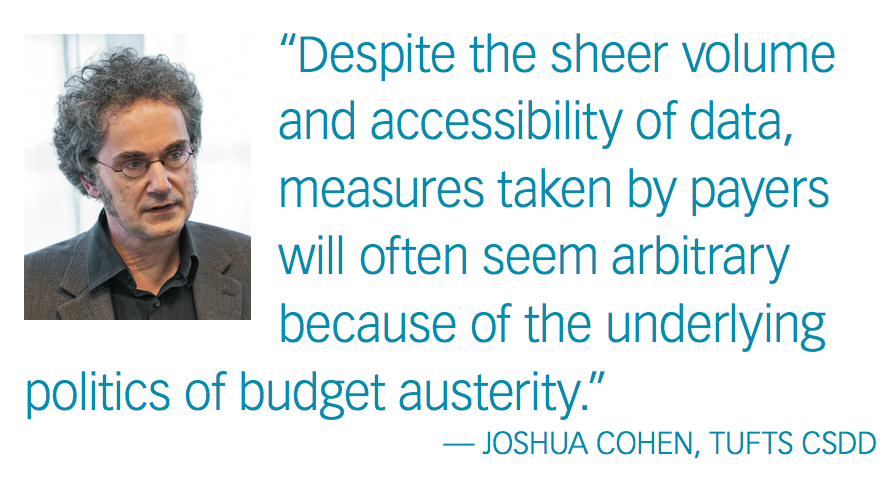
industry has to accommodate to the idea of many of its technologies being cost-effective, but not cost-saving, because new drugs will usually cost more than the existing standard of care. Where I think more needs to be done is in preparing payers to help estimate the potential financial burden from reimbursing a new medicine to those who need it. We did not see this prior to the US rollout of the new hepatitis C cures last year, and the payer reaction was harsh. Drug companies must pinpoint the prevalence of the diseases they are treating and be very precise in establishing just how many patients will benefit, and, thus, be eligible, for treatment. This is an area where pharmacoepidemiology has much to contribute.
Blackburn: Cost concerns are arbitrated in the real world, not in the traditional world of the randomized clinical trial. Hence, as cost becomes more important, pharmacoepidemiology can only rise in prominence. RCTs are useful, but you need to carry on to the bedside to get the truth about what happens to a patient when he takes a drug. It’s precisely why we are now having the debate over different standards of evidence as part of the 21st Century Cures legislation now before the US Congress.
William Looney is Pharm Exec's Editor-in-Chief. He can be reached at wlooney@advanstar.com.
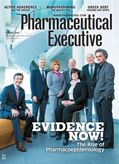
An Evolving ‘Opinion’ Landscape: New Paths—and Synergies—for Pharma KOLs & DOLs
October 13th 2023Industry experts discuss the relationship between digital and traditional (key) opinion leaders and how companies are adjusting their strategies to harness the unique brand engagement benefits each role can provide in driving better patient outcomes.